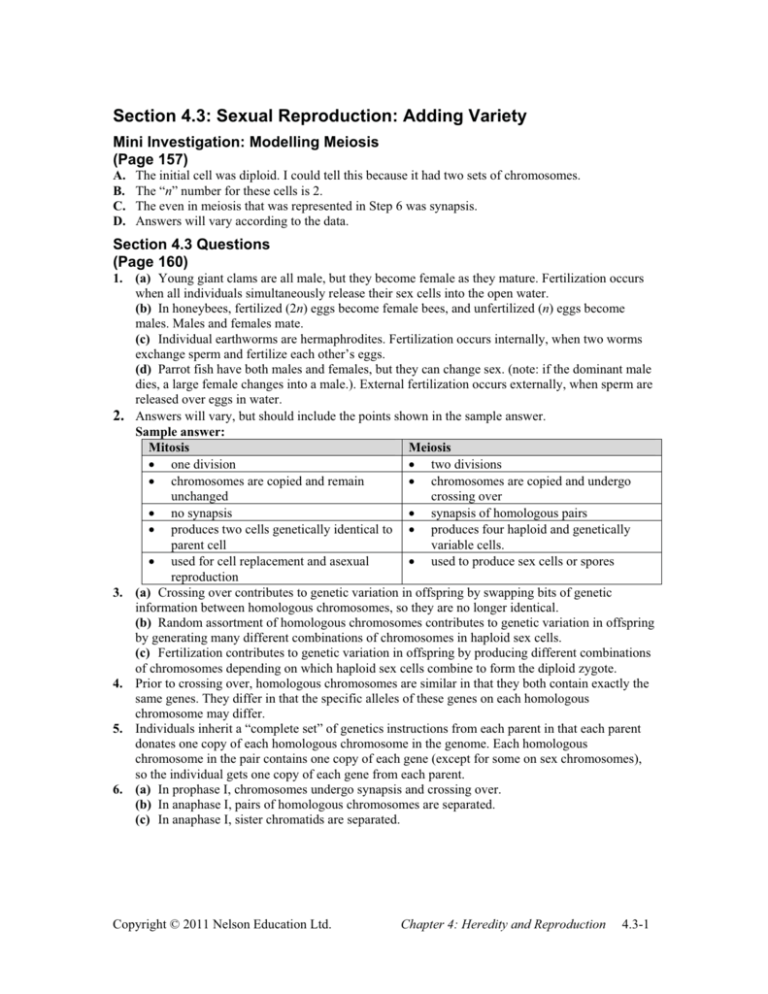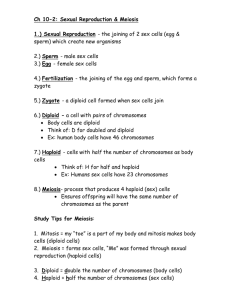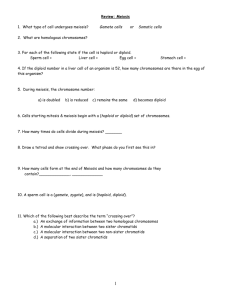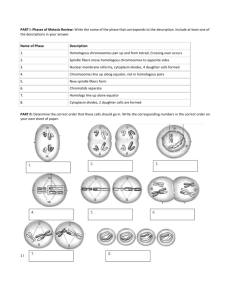Answers p. 160
advertisement

Section 4.3: Sexual Reproduction: Adding Variety Mini Investigation: Modelling Meiosis (Page 157) A. B. C. D. The initial cell was diploid. I could tell this because it had two sets of chromosomes. The “n” number for these cells is 2. The even in meiosis that was represented in Step 6 was synapsis. Answers will vary according to the data. Section 4.3 Questions (Page 160) 1. (a) Young giant clams are all male, but they become female as they mature. Fertilization occurs when all individuals simultaneously release their sex cells into the open water. (b) In honeybees, fertilized (2n) eggs become female bees, and unfertilized (n) eggs become males. Males and females mate. (c) Individual earthworms are hermaphrodites. Fertilization occurs internally, when two worms exchange sperm and fertilize each other’s eggs. (d) Parrot fish have both males and females, but they can change sex. (note: if the dominant male dies, a large female changes into a male.). External fertilization occurs externally, when sperm are released over eggs in water. 2. Answers will vary, but should include the points shown in the sample answer. Sample answer: Mitosis Meiosis x one division x two divisions x chromosomes are copied and remain x chromosomes are copied and undergo unchanged crossing over x no synapsis x synapsis of homologous pairs x produces two cells genetically identical to x produces four haploid and genetically parent cell variable cells. x used for cell replacement and asexual x used to produce sex cells or spores reproduction 3. (a) Crossing over contributes to genetic variation in offspring by swapping bits of genetic information between homologous chromosomes, so they are no longer identical. (b) Random assortment of homologous chromosomes contributes to genetic variation in offspring by generating many different combinations of chromosomes in haploid sex cells. (c) Fertilization contributes to genetic variation in offspring by producing different combinations of chromosomes depending on which haploid sex cells combine to form the diploid zygote. 4. Prior to crossing over, homologous chromosomes are similar in that they both contain exactly the same genes. They differ in that the specific alleles of these genes on each homologous chromosome may differ. 5. Individuals inherit a “complete set” of genetics instructions from each parent in that each parent donates one copy of each homologous chromosome in the genome. Each homologous chromosome in the pair contains one copy of each gene (except for some on sex chromosomes), so the individual gets one copy of each gene from each parent. 6. (a) In prophase I, chromosomes undergo synapsis and crossing over. (b) In anaphase I, pairs of homologous chromosomes are separated. (c) In anaphase I, sister chromatids are separated. Copyright © 2011 Nelson Education Ltd. Chapter 4: Heredity and Reproduction 4.3-1 7. (a), (b) Students’ answers will be the filled-in Table 3, as below. Table 3 Human Earthworm Hedgehog Broccoli Before Meiosis chromosome number 46 36 90 18 (haploid or diploid) diploid diploid diploid diploid number of pairs of homologous 23 18 45 9 chromosomes diploid diploid diploid diploid After Meiosis I chromosome number 23 18 45 9 (haploid or diploid haploid haploid haploid haploid After Meiosis II chromosome number 23 18 45 9 (haploid or diploid) haploid haploid haploid haploid number of pairs of homologous 0 0 0 0 chromosomes 8. Cells change from being diploid to being haploid during anaphase I (during the first division). 9. The number of different arrangements of chromosomes possible in gametes is 2n. For a cell that has 10 chromosomes at the beginning of meiosis, then n=5 and the number of possible arrangements is 32. 10. 11. It can be beneficial for an organism to produce only one large egg cell during oogenesis and have three polar bodies that die because a single, large egg cell will contain lots of nutrients to supply the early growing embryo. It can, in contrast, be beneficial for males to produce very large numbers of small sperm because having large numbers increases the chances of a sperm being able to reach and fertilize the egg. It is easier to produce many sperm if they are small, since each individual cell takes up few resources. 12. Answers will vary, but should give all the information in the sample answer. Sample answer: The green spoonworm is a marine worms with very unusual sex-determination. When they are first born, green spoonworms are microscopic larvae with indeterminate sex. The larvae land on the sea bottom and, if isolated, slowly grow into large females. However, if they contact a female when they are larvae, they enter her feeding tube (they are taken in as if they were a food item). These larvae change into tiny males within the female’s body, where they live and produce sperm. 13. (a) In this activity, the chance of getting heads or tails on a coin was random and had a 50 % probability. Similarly, during random assortment of chromosomes, there is a 50 % chance that a cell will get either one of the two homologous chromosomes in a pair during meiosis I. (b) The investigation modeled eight homologous pairs of chromosomes. Copyright © 2011 Nelson Education Ltd. Chapter 4: Heredity and Reproduction 4.3-2 (c) The number of different arrangements of chromosomes possible in gametes is 2n. For a cell in which n=8, the number of possible arrangements is 28, or 256. Copyright © 2011 Nelson Education Ltd. Chapter 4: Heredity and Reproduction 4.3-3









